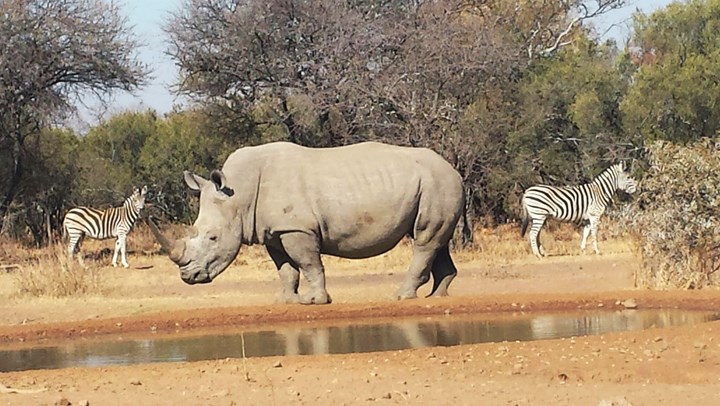
by Catherine Semcer - Monday, July 25, 2016

Thanks to the efforts of trophy hunters, the white rhino represents one of Africa’s greatest conservation success stories. From a population low of 1800 in 1968, they have flourished to over 20,000 animals under legal hunting programs that have created incentives for landowners to manage areas for the species. The potential for this success to be undermined by industrial-scale poaching for rhino horn—by international criminal syndicates supplying practitioners of traditional Asian medicine—has rightfully captured global attention.
However, the depth of Africa’s poaching crisis goes much further than the charismatic wildlife that makes global headlines. As a Washington Post story recently highlighted, millions of animals are being killed each year in Zambia and in other nations across Africa to supply an unregulated and illegal trade in bushmeat that threatens to undermine the viability of both conservation areas and the tourism industry. The illegal bushmeat trade grows out of both food insecurity and a lack of local investment in the success of conservation areas. Addressing it is a more complicated undertaking than simply boosting the capabilities of anti-poaching guards. Despite that complexity, hunting operators across Africa are leading local efforts to decrease poaching for bushmeat while still ensuring local needs are met, wildlife is conserved and rural economies have opportunities to grow.
The nation of Kenya, where trophy hunting was banned in 1977, presents an especially grim picture of the devastating impact the illegal bushmeat trade can have. There, the poaching of animals to supply illegal bushmeat has contributed to a 70 percent decline in big game animals including Cape buffalo, eland, giraffe and waterbuck. Rather than conserving wildlife, Kenya’s official closure to the international hunting industry removed incentives for wildlife conservation. It has allowed an unregulated black market in wildlife to flourish to the point that a 2014 report from the Kenyan Ministry of Environment, Water and Natural Resources said poaching for bushmeat was reaching unprecedented levels—and surpassing elephant poaching in its scale.
Trophy Hunters and Outfitters: Cracking Down on Poaching
Conservation organizations support wild game meat being available to feed Africa’s growing population. The challenge is making sure this renewable resource is sustainably utilized. Experience shows that where trophy hunting outfitters are allowed to operate, poaching for bushmeat decreases while local people have access to the critical protein wildlife provides.
In Mozambique’s Coutada 11, one of H.O.P.E.’s partners, Zambeze Delta Safaris (ZDS), is implementing a program where local villagers are provided weekly meat deliveries from trophy animals shot by hunting clients and non-trophy animals shot by ZDS staff or H.O.P.E. contractors. Each villager receives 11 pounds of meat per week, more than enough to provide for their nutritional needs. To further disincentivize the bushmeat trade, if a local villager is found poaching, their village’s meat allocation is temporarily reduced and they are turned over to village elders for trial and judgment. Those found guilty are typically sentenced to a period of labor with conservation programs in the hunting concession.
By managing wildlife herds for trophy hunting, the animals are given increased ability to benefit the local population. For example, if killed for its meat alone, a reedbuck is worth approximately $30 on the illegal bushmeat market. While local people will benefit from eating that meat, they must first pay for it. The poacher alone keeps any cash from the sales. If that reedbuck is killed by a visiting hunter, its economic value increases to a minimum of $1,450, including services and fees, and its economic impact extends to providing meat to local people free of charge as well as providing capital to pay the 150 local villagers ZDS employs to maintain its camps and conduct anti-poaching operations.
What does this mean for wildlife conservation? In Coutada 11, where ZDS operates, the number of sable antelope in the concession has increased from just 44 in 1992, to 3,000 today and the number of Cape buffalo from 1,200 to 21,000. Their programs also have helped the region where their concession is located to be one of the only in Mozambique to see a net increase in elephants.
Common Sense and Public Education: The Winning Combo
The example from Coutada 11 shows the valuable role that hunting and hunters can play in reducing the illegal trade in bushmeat and promoting the sustainable use of Africa’s wildlife resources—while at the same time feeding Africa’s growing population and creating economic opportunity in rural communities. Unfortunately, animal rights extremists continue to spread the falsehood that trophy hunting is the same as poaching and is contributing to declines in Africa’s wildlife. The more they are successful in converting this untruth into public and corporate policies that discourage trophy hunting, the more Africa’s wildlife—and the people who depend on it for their livelihoods and well being—will be at risk. It is up to hunters to educate decision makers and the public about the important role hunting plays in conservation—and about the wildlife and humanitarian disaster that awaits should the agenda of the animal rights extremists be fully realized.
About the Author
Catherine E. Semcer is Chief Operations Officer of Humanitarian Operations Protecting Elephants (H.O.P.E.), a U.S.-based non-profit organization that provides training, advisory assistance and procurement services to African anti-poaching programs by leveraging the skill sets of U.S. veterans and the capacities of commercial businesses. A longtime hunter, Semcer is also a member of the International Union for Conservation of Nature’s (ICUN) Sustainable Use Livelihoods Specialist Group, a global-expert network that promotes both conservation and livelihoods through enhancing equitable and sustainable use of wild species and their associated ecosystems. You can support H.O.P.E.’s efforts to secure a future for Africa’s wildlife by visiting www.saveivory.org.
*Please note that the opinions expressed in this article are her own.
E-mail your comments/questions about this site to:
[email protected]
